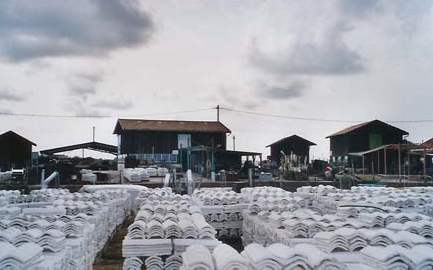

|
Captage! The oystermen of Arcachon have long perfected the "captage" of baby oysters. Instead of Greek broken pottery, they use lots of specially coated clay roofing tile. Not just any clay roofing tile will do the best job. Arcachon oystermen use the clay tile used for the roof ridge (or "hip"). A ridge tile looks a little like what's left, when a short section of a big drain pipe has been cut diagonally in half. It leaves two equal pieces, each half now offering a convex and a concave side. Arcachon oystermen call these ridge tiles "collecteurs" (collectors). The tiles are anywhere from 18" to 2' long. The most important side is the concave side, as it is here, where most of the "oyster babies" will ultimately "collect".  In 1865, an ingenious French bricklayer
by the name of Michelet came up with the idea of coating
these clay ridge tiles with a form of mortar - a mixture of cement,
lime, or gypsum plaster with sand and fresh water which ultimately
hardens. The famous American naturalist and oyster
specialist William K. Brooks noted this procedure in 1891 in
his famous book "The Oyster". On page 114 he reveals
a recipe for the coating: The beauty of this "sandy plaster
coating" on these tiles is that once baby oysters have cemented
themselves to it, skilled hands can later pry them off nicely
with a special knife. Most of the time, the little oysters remain
unharmed. Once removed, all the little oysters are placed into
large square growing bins in the tidal zone, protected from predators
by meshing. Here they can grow some more until the moment when
they are sold and shipped to a grower - possibly in the North
of France or even Ireland. The buyers can usually select from
a few sizes - the bigger the oyster baby purchased, the hardier
it will be and the sooner it will grow out to market size wherever
it ends up. "Big oyster babies" are hence more expensive
than "small oyster babies". What is also remarkable
about the plaster mix, is that it renders individual oysters
without "anything stuck to them", as for instance an
unsightly chunk of shell or an ugly piece of tile. Essentially,
they are similar to what American oyster growers call "cultchless
seed oysters" (produced in an entirely different manner
in American marine laboratories). Baby oysters of this type are
perfectly suited for the "rack and bag" cultivation
method, the predominant cultivation method used in Europe. It
produces oysters with a superior shell form - ideal for slurping
off the half shell. Inset image from an old post card ca. 1910:
A hard working, yet nonetheless pleasant "parqueuse"
from Arcachon. She is working on the preparation of the tiles.
The stacks are her work stacks, not the "bee hives"
(wooden frames containing tiles) in which the tiles are ultimately
submerged with the concave side down (instead of up as pictured).
She is wearing traditional wooden "oyster galoshes"
and also holds an interesting rake-like tool in her right hand
used once in some phase of the preparation of the tiles (name
and exact application unknown to this writer). But before Arcachon oystermen can dream about "oyster baby profits", they of course have to capture them first. They certainly mean business: about 25 million of these specially prepared ridge tiles are used annually for the "captage". The tiles are usually stacked up in openly designed wood or metal cages (so called "bee hives"). Most tile cages are placed in the intertidal zone. Some tile cages are lowered in the subtidal zone. The individual tiles are all stacked with the concave side down. First, the tiles are placed side by side in the frame as a base. Then, another layer of tiles is placed on top of them at right angles. On top of them, a third layer is stacked, matching the arrangement of the base tiles. The fourth layer is then stacked again at right angles - and so on. Since tiles are heavy (and fragile), the handling of these "collecteurs" is back breaking work. Timing is of the essence. Much like the "old pair of boots" mentioned earlier, the tiles must be "fresh and attractive" for the oyster larvae instead of overgrown, silted and slimy. Thus, the prepared tiles should not sit out in the bay too long before that moment. The idea is to keep the marine fouling to a minimum. Strategic positioning of the tile cages near oyster beds and experience with the prevailing currents in particular areas is crucial. The two to three weeks the oyster larvae swim around the Arcachon Bay is a time of nervous nail biting for the oystermen. There is always the worry about a poor oyster spawn or the risk of a sudden cold spell or thunderstorm which could wipe out most (or conceivably all) of the most vulnerable swimming oyster larvae. Far more often than not, these tiles end up being loaded with countless oyster babies. They are left in the bay for about six months, usually until spring. Then, all the tiles are collected and all the little oysters are carefully carved from their chalky homes by skilled hands. By then, many oyster growers are already anxiously waiting to buy "oyster babies from Arcachon".
Health advisory: There is a risk associated with consuming raw oysters or any raw animal protein. If you have chronic illness of the liver, stomach, or blood or have immune disorders, you are at greatest risk of illness from raw oysters and should eat oysters fully cooked. If you are unsure of your risk, you should consult your physician.
This site is maintained as an archive. Contact: |